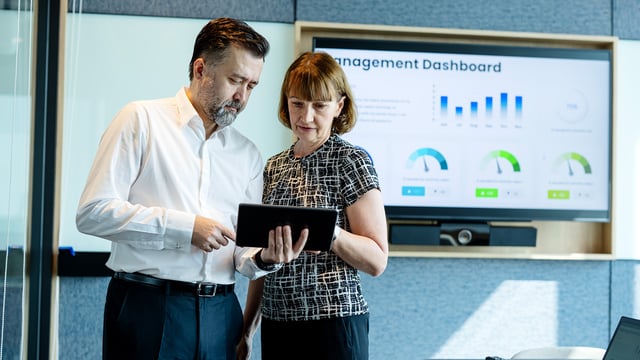- Home
- IT Monitoring
- System Monitoring
System Monitoring
Everything you need in one place
Server & applications at a glance
Clever capacity management
Mainframe monitoring at the top level
IT, climate, buildings - everything at a glance
System monitoring: Everything in view before anything happens
With our system monitoring tool, you can keep your entire IT infrastructure under control—from classic on-premises systems to hybrid environments and modern cloud solutions.
Our goal: to detect faults before they become a problem. The software supports your IT team in avoiding outages, keeping processes stable and ensuring the satisfaction of your users.
The intuitive functions make day-to-day work easier, increase system performance and ensure secure, reliable IT operations.
System monitoring explained in just 1 minute!
Application & Server Monitoring (APM):
With our Application & Server Monitoring (APM), you can keep an eye on the performance and availability of your servers and applications at all times—centrally, automatically and in real time.
Whether classic server landscapes or modern cloud environments: The solution continuously records important key figures such as CPU, memory and network utilization and helps you to identify and resolve bottlenecks at an early stage. This ensures stable processes, reduces the workload on your IT team and increases user satisfaction.

Highlights at a glance:
- Agent-based and agentless monitoring (e.g. via databases, WMI, log analyses)
- Central distribution and versioning
- Integrated alerting in the event of deviations
- Cloud connectors for AWS, Azure, Google Cloud and Oracle—including automatic discovery
- Over 650 plug-ins for applications and systems—ready for immediate use
- Dashboards that simplify error analyses—multi-client capable and intuitive
- Capacity planning and trends thanks to integrated reporting and forecasting
- Seamless integration with USU alarm management
APM makes your IT ready for today—and tomorrow.
Discover how easy monitoring can be—powerful, flexible and cost-efficient.
Capacity management
With integrated capacity management, you can keep track of your IT capacities—proactively, efficiently and cost-consciously. You ensure that your resources always match the service requirements (SLAs)—without losing sight of the budget. The solution not only shows you how your IT is currently being used, but also actively supports you in strategic planning. So you are ready for whatever comes next—flexibly, scalably and economically.

What capacity management can do for you
Forecasts & trends
- Plan capacities precisely with data-based analyses and observability.
- Recognize bottlenecks early and avoid risks with trends and forecasts.
- React quickly to new requirements—for stable processes.
Align resources optimally
- Avoid overload and underload by allocating resources precisely.
- Increase performance through targeted use of previously unused capacities.
- Reduce costs & act sustainably through efficient resource utilization.
Rely on planning with foresight—and make your IT future-proof.
Data center & building infrastructure monitoring
Smart monitoring of building technology:
Everything at a glance—from the room temperature to the power supply. With data center & building infrastructure monitoring, you can keep your building technology under control at all times—whether it's temperature, energy consumption or air conditioning. A stable infrastructure is the basis for smooth IT processes and secure working. Our solution helps you to identify risks at an early stage, use resources efficiently and avoid outages.

You monitor your entire building and data center infrastructure centrally—directly and in real time. This includes analyzing power consumption, controlling UPS systems, monitoring the indoor climate and integrating external systems such as building management systems or fire alarm panels. All the collected data comes together in a clear dashboard. This allows you to see at a glance whether your infrastructure is stable or whether there is a need for action. The system warns you automatically in the event of critical values—for maximum operational reliability and fast reactions.
With over 40 years of experience in monitoring data centers and building infrastructure, we know what is important: A solution that works reliably, is easy to use and can be flexibly expanded. So you are ideally positioned—today and tomorrow.
Your benefits at a glance:
-
Holistic monitoring
Comprehensive monitoring of IT and building technology—beyond ITIL® boundaries. -
Direct and indirect data acquisition
Keep an eye on room temperature, power consumption, air conditioning performance, UPS status and more. - Connection of external systems
Expand your monitoring with data from building management systems or fire alarm systems. - Maximum operational reliability
Detect risks at an early stage and react quickly—for stable services. - Proactive alerting
Automatic notifications in the event of threshold violations—fast, secure, reliable.
- Central dashboard
All information from infrastructure and IT services at a glance—in real time.
Mainframe monitoring
Monitoring for stable mainframe IT and maximum availability
With our solution for mainframe monitoring, you can keep an eye on your business-critical processes at all times—securely, efficiently and with high availability. Especially in complex IT environments in which mainframes play a central role, maximum stability and control are essential. This is exactly where our software comes in.

Our mainframe monitoring solution has been specially developed for companies that place the highest demands on performance, security and availability. You not only monitor your systems in real time, but also react automatically and in a targeted manner in the event of faults—even under extreme conditions.
Detect relevant events—intelligently filtered and in the right context.
- Console monitoring & remote operations
Operate your systems securely and in parallel—even remotely. - IPL management & heartbeat checks
Monitor and control all important start-up and control processes. - HMC control & monitoring
Keep an eye on your hardware management console at all times. - Authorization concept with clear roles
Assign specific access rights and create operational security.
With over 40 years of experience in system monitoring, we provide you with a solution that makes your mainframe environment transparent, secure and efficient—today and in the future.
Your IT always in view—simple and secure
System status at a glance at all times:
System status, utilization and alerts—clear, up-to-date, ready for action
Central system monitoring:
Everything at a glance: Current system statuses, critical events and capacity utilization—compact, clear, live
Clever management of IT capacities:
Capacity management ensures that IT resources are planned in advance and bottlenecks are identified at an early stage.
Smarter system monitoring starts with USU
Cloud monitoring ready for immediate use
Faster insight with AI
Plug-ins for every system landscape
Intelligent dashboards, more control
Proactive alerting in the event of faults
IT and building technology at a glance
Planning & forecasting in one tool
IPL management & heartbeat checks
Authorization concept with clear roles
Get in touch with an expert
Have questions about our offering? A quick call can be way more helpful than a long email chain. Talk to one of our experts to explore our products and see them in action.

Brian Riley
Sales Development
IT Monitoring
Send us a message
No matter if you like to partner with USU or just have a few questions.
Frequently Asked Questions
What is System Monitoring?
System monitoring is a comprehensive solution for monitoring your entire IT infrastructure—from servers and applications to cloud services and data centers. It provides you with real-time insights into system statuses, performance data and potential faults in order to prevent failures and optimize performance.
Which systems and environments are supported?
System monitoring covers a wide range of IT components—from classic on-premises systems and virtual environments to cloud infrastructures such as AWS, Azure, Google Cloud or Oracle Cloud.
Applications such as SAP, Kubernetes or Citrix can also be seamlessly integrated—with over 650 ready-to-use plug-ins. In addition, USU also offers comprehensive building infrastructure monitoring. You can keep an eye on your building technology at all times—such as temperature, energy consumption or air conditioning performance. A stable infrastructure is the basis for smooth IT processes and secure operations. With USU, you can identify risks at an early stage, use resources efficiently and avoid expensive downtime.
How does USU help with error detection and correction?
Automated alarms and intelligent dashboards allow you to detect faults at an early stage. The solution offers detailed analyses and historical data to quickly identify causes and rectify them in a targeted manner.
Is the solution scalable and multi-client capable?
Yes, USU System Monitoring is fully scalable and multi-client capable. You can create individual dashboards for different teams, departments or customers and thus efficiently map specific requirements.
What are the advantages of integrated capacity management?
How is the alarm raised in the event of critical incidents?
The integrated alarm management ensures that you are informed immediately in the event of critical events. As soon as defined threshold values are exceeded, you receive automatic notifications—by email, SMS, ticket or directly in the dashboard.
This enables your teams to react quickly, avoid downtime and rectify IT faults in a targeted manner. You configure which notifications go to whom—individually, precisely and comprehensibly. In short, more security, less response time—and full control over your IT.
.jpg?width=296&height=197&name=usu_itm_wp_performance%26capacity_lp-header_1920x1080px%20(1).jpg)



